Overview
- Brief Narrative
- Plate 6 in a folio of 12 prints by Leo Haas published in Prague in 1947. The works are based on scenes experienced or witnessed by Haas, a labor and concentration camp prisoner for nearly six years. Each print has an introductory paragraph by Milos Vacik, a poet jailed for anti-Nazi resistance activity. Haas, 38, a Czech Jew and professional artist, was arrested in 1939, deported to Nisko labor camp in Poland, and then shipped back to Ostrava in German occupied Czechoslovakia to do forced labor. In September 1942, he was sent to Theresienstadt ghetto-labor camp, where he and a group of fellow artists determined to secretly document the terrible conditions of daily life in the camp. In summer 1944, they were accused by the Gestapo of smuggling their 'gruesome', that is, truthful, work out of the camp. Haas was arrested and tortured. In October, he was deported to Auschwitz, and a month later, to Sachsenhausen. In February 1945, he was transported to Mauthausen and then Ebensee concentration camp, where he was liberated on May 4-5 by US troops.
- Series Title
- 12 puvodnich litografii z nemeckych koncentracnich taboru Leo Haas
- Date
-
publication/distribution:
1947
- Geography
-
publication:
Prague (Czech Republic)
- Credit Line
- United States Holocaust Memorial Museum Collection, Gift of Dr. and Mrs. Ivan Kalina
- Contributor
-
Artist:
Leo Haas
Subject: Leo Haas
Publisher: Vydal Svaz Ozvobozenych Politickych Veznu a Pozu?stalych Po Politickych Veznich
Author: Frantisek Halas
Author: Milos Vacik
- Biography
-
Leo Haas was born on April 15, 1901, in Opava, Czechoslovakia, Austro-Hungary (now Czech Republic), formerly Troppau, an ethnic German region in Silesia. Leo was the oldest of four children in a Jewish family. He received art training while a youth. In 1919, Haas moved to Karlsruhe, Germany, to attend the Art Academy. He supported himself by working as a musician in local bars and by selling paintings. In 1922, he moved to Berlin where he studied with Emil Orlik and Wilhelm Jäckel. He absorbed the bold, dramatic styles of the Expressionist and Modernist movements flourishing in the city. He closely studied the work of graphic artists such as Goya and Toulouse-Lautrec in his 1923 travels in France. In 1925, he moved to Vienna, Austria, and established himself as a portraitist and newspaper caricaturist. In 1926, Haas returned to Opava, where he continued his career as painter and graphic artist, and set up a lithography studio. He also designed sets for a local theater troupe. Haas married Sophie Hermann in 1929. He was active in the Communist Party and several artist’s cooperatives. In the fall of 1938, Nazi Germany annexed the Sudetenland border of Czechoslovakia, which included Opava. Antisemitism surged after the takeover. Haas’s work was denounced as degenerate. After the Kristallnacht pogrom on early November, he and his wife moved to Ostrava to live with her parents.
In March 1939, Germany annexed the provinces of Bohemia and Moravia. German allies took over other regions and Czechoslovakia ceased to exist. There were widespread arrests of Jews, Communists, and prominent community members. In June, Jews were barred from most economic activity and property was confiscated. That September, Germany invaded Poland, the start of the Second World War. Haas was arrested for being a Communist and sent to Nisko labor camp near Lublin in German occupied Poland, where he drove supply wagons. He made portraits of SS camp personnel, in exchange for extra food and art supplies. He also secretly made drawings of camp life, of which over 100 were saved. The camp closed circa April 1940, and Haas returned to Ostrava. His wife fled, but Haas would not leave his father and sister. He did forced labor in the sewers. He met Erna Davidovitc, who became his second wife. Her parents were involved in underground activities, helping people and goods to cross borders illegally. After his father died in 1941, Haas joined in this work.
In August 1942, Haas was arrested by the Gestapo for smuggling. He was released but on September 30, Haas, Erna, her parents, and his sister Elvina were sent on transport Bm to Theresienstadt ghetto-labor camp. Men and women were housed separately at the camp. Haas was initially assigned to the railroad construction crew. But he was soon transferred to the technical department, headed by Bedrich Fritta, which created artwork, maps, charts, and other materials for the German SS camp administrators. Their work included architectural drawings which allowed them to move around the camp. It also gave them access to art supplies and Haas and a group of artist dedicated themselves to documenting the dreadful conditions of daily camp life, such as the search for food, prisoner transports, starving and hanged prisoners, and the many ill and dying residents. They met secretly at night to draw, as their accurate recording of camp activity was forbidden. Some artwork was smuggled out of the camp, while the remainder was hidden throughout the camp, in the walls, or buried. The technical department worked on the beautification project as the SS prepared the camp for a June 23, 1944, Red Cross visit.
Later the month, the SS discovered that drawings had been smuggled out of the camp. Haas, Fritta, Ungar, and Ferdinand Bloch were arrested. On July 17, they were sent to the Gestapo prison in the Small Fortress. Their families were arrested: Leo’s wife Erna, Fritta’s wife Hansi and their 3 year old son Tomas, Felix Bloch’s companion, Otto Ungar’s wife and 5 year old daughter. The art dealer Leo Strauss and his wife who helped smuggle the art were jailed. The men were taken to the basement, beaten, tortured, and interrogated by Adolf Eichmann and an officer named Günther. No one confessed. Haas later described how Eichmann “acted as if he were in the deepest soul affected by the slanderous accusations.” Gunther showed him a work with skeletal Jews fighting over potato skins and asked how he could make such a reality distorting drawing? Did he really think there was starvation the ghetto? The Red Cross did not find this?" The men were assigned to hard labor constructing railroad lines. Haas’s leg was injured, but with help from his friends was able to recover. In October 1944, they were convicted of distributing atrocity propaganda outside the camp.
Haas and Fritta were deported to Auschwitz, arriving there on October 28, 1944. Haas was assigned prisoner number 199885. Fritta died a week later of blood poisoning. For the next three weeks, Haas worked in Block 24, and made sketches for Dr. Josef Mengele. Subsequently, he was transferred to Sachsenhausen concentration camp and issued a new prisoner number 118029. He was assigned to the counterfeiting unit working on fake US currency. At the end of February 1945, Haas and his group were transferred to Mauthausen, and in April to Redl-Zipf and Schlier labor camps. On May 5, he was taken to Ebensee concentration camp where he was liberated the next day by American troops.
The war ended when Germany surrendered on May 7. When Haas was allowed to leave Ebensee, he returned to Theresienstadt, where he found all his hidden works, nearly 400, as well as many works by Fritta, Ungar, and Fleischmann. He reunited with his wife Erna, who had survived a year in solitary imprisonment and was in very poor health. Many of his friends had been killed. Fritta’s wife died of illness in Theresienstadt in February 1945. Bloch was beat to death by the Gestapo in the Small Fortress in October 1944. Ungar, the first of the group deported to Auschwitz, was eventually sent to Buchenwald where he died of typhus shorty after liberation in April 1945. His wife Frida and daughter Susanna survived. Leo Strauss and his wife were murdered in Auschwitz.
Haas and Erna adopted Tomas (1941-2015), the orphaned son of Bedrich Fritta and settled in Prague. Haas remained a committed Communist, taught at the Art Academy, and was a celebrated editorial cartoonist. A book of lithographs of his drawings of camp life was published in 1947. Haas also ensured that the work of Fritta and the others was publicly displayed to bear witness to the machinations of the Nazi’s planned final solution. Following Erna's death in 1955, Haas moved to East Berlin, where he was the editor of a satiric illustrated journal, Eulenspiegel. His third wife was named Inge. Haas also designed movie sets for DEFA and East German television. He exhibited his artwork widely, and continued to create works exploring the misery of life in the camps. Haas donated most of his wartime work to the Terezin Memorial and the State Jewish Museum in Prague. Haas, 78, died in 1983.
Physical Details
- Classification
-
Books and Published Materials
- Category
-
Books and pamphlets
- Object Type
-
Portfolios (groups of works) (aat)
- Physical Description
- folio: [6] pages (text), [12] leaves of plates, numbered in left corner; 34 x 48 cm
Text in English, French, Czech and Russian.
"5000 výtisků"--verso of t.p.
Image of prisoner being beaten - Inscription
- "1"
Rights & Restrictions
- Conditions on Access
- No restrictions on access
- Conditions on Use
- Restrictions on use
Keywords & Subjects
- Topical Term
- Concentration camp inmates as artists--Biography. Concentration camps in art. Concentration camps--Pictorial works. Holocaust, Jewish (1939-1945), in art. Holocaust, Jewish (1939-1945)--Personal narratives. Jewish artists--Germany (East)--Biography. World War, 1939-1945--Concentration camps--Pictorial works.
- Personal Name
- Haas, Leo, 1901-1983.
Administrative Notes
- Legal Status
- Permanent Collection
- Provenance
- The folio was donated to the United States Holocaust Memorial Museum in 1989 by Dr. and Mrs. Ivan Kalina.
- Funding Note
- The cataloging of this artifact has been supported by a grant from the Conference on Jewish Material Claims Against Germany.
- Record last modified:
- 2024-04-29 07:55:44
- This page:
- https://collections.ushmm.org/search/catalog/irn917
Download & Licensing
In-Person Research
- By Appointment
- Request 21 Days in Advance of Visit
- Plan a Research Visit
- Request to See This Object
Contact Us
Also in Leo Haas collection
The collection consists of a publication, 12 puvodnich litografii z německych koncentracnich taboru Leo Haas, a set of lithographs created by Leo Haas about the concentration camps where he was imprisoned during World War II, that was published in Prague, Czechoslovakia, in 1947.
Date: 1947
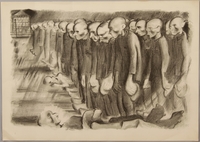
Portfolio
Object
Plate 1 in a folio of 12 prints by Leo Haas published in Prague in 1947. It depicts corpselike concentration camp inmates gathered for appell [roll call]: ."..long rows of white skulls, glowing as a mass seemingly less alive than cold light...." The works are based on scenes experienced or witnessed by Haas, a labor and concentration camp prisoner for six years, from 1939-1945. Each print has an introductory paragraph by Milos Vacik, a poet jailed for anti-Nazi resistance activity. Haas, 38, a Czech Jew and professional artist, was arrested in 1939, deported to Nisko labor camp in Poland, and then shipped back to Ostrava in German occupied Czechoslovakia to do forced labor. In September 1942, he was sent to Theresienstadt ghetto-labor camp, where he and a group of fellow artists determined to secretly document the terrible conditions of daily life in the camp. In summer 1944, Haas, Bedrich Fritta, Otto Ungar, and Ferdinand Bloch were accused by the Gestapo of smuggling their 'gruesome', that is, truthful, work out of the camp. Haas was arrested and tortured. In October, he was deported to Auschwitz, and a month later, to Sachsenhausen. In February 1945, he was transported to Mauthausen and then Ebensee concentration camp, where he was liberated on May 4-5 by US troops.
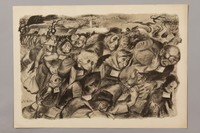
Portfolio
Object
Plate 2 in a folio of 12 prints by Leo Haas published in Prague in 1947. It depicts corpselike concentration camp inmates gathered for appell [roll call]: ."..long rows of white skulls, glowing as a mass seemingly less alive than cold light...." The works are based on scenes experienced or witnessed by Haas, a labor and concentration camp prisoner for nearly six years. Each print has an introductory paragraph by Milos Vacik, a poet jailed for anti-Nazi resistance activity. Haas, 38, a Czech Jew and professional artist, was arrested in 1939, deported to Nisko labor camp in Poland, and then shipped back to Ostrava in German occupied Czechoslovakia to do forced labor. In September 1942, he was sent to Theresienstadt ghetto-labor camp, where he and a group of fellow artists determined to secretly document the terrible conditions of daily life in the camp. In summer 1944, Haas, Bedrich Fritta, Otto Ungar, and Ferdinand Bloch were accused by the Gestapo of smuggling their 'gruesome', that is, truthful, work out of the camp. Haas was arrested and tortured. In October, he was deported to Auschwitz, and a month later, to Sachsenhausen. In February 1945, he was transported to Mauthausen and then Ebensee concentration camp, where he was liberated on May 4-5 by US troops.
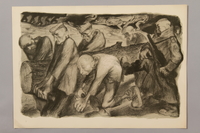
Portfolio
Object
Plate 3 in a folio of 12 prints by Leo Haas published in Prague in 1947. The works are based on scenes experienced or witnessed by Haas, a labor and concentration camp prisoner for nearly six years. Each print has an introductory paragraph by Milos Vacik, a poet jailed for anti-Nazi resistance activity. Haas, 38, a Czech Jew and professional artist, was arrested in 1939, deported to Nisko labor camp in Poland, and then shipped back to Ostrava in German occupied Czechoslovakia to do forced labor. In September 1942, he was sent to Theresienstadt ghetto-labor camp, where he and a group of fellow artists determined to secretly document the terrible conditions of daily life in the camp. In summer 1944, they were accused by the Gestapo of smuggling their 'gruesome', that is, truthful, work out of the camp. Haas was arrested and tortured. In October, he was deported to Auschwitz, and a month later, to Sachsenhausen. In February 1945, he was transported to Mauthausen and then Ebensee concentration camp, where he was liberated on May 4-5 by US troops.
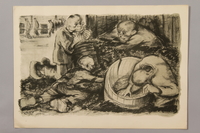
Portfolio
Object
Plate 4 in a folio of 12 prints by Leo Haas published in Prague in 1947. The works are based on scenes experienced or witnessed by Haas, a labor and concentration camp prisoner for nearly six years. Each print has an introductory paragraph by Milos Vacik, a poet jailed for anti-Nazi resistance activity. Haas, 38, a Czech Jew and professional artist, was arrested in 1939, deported to Nisko labor camp in Poland, and then shipped back to Ostrava in German occupied Czechoslovakia to do forced labor. In September 1942, he was sent to Theresienstadt ghetto-labor camp, where he and a group of fellow artists determined to secretly document the terrible conditions of daily life in the camp. In summer 1944, they were accused by the Gestapo of smuggling their 'gruesome', that is, truthful, work out of the camp. Haas was arrested and tortured. In October, he was deported to Auschwitz, and a month later, to Sachsenhausen. In February 1945, he was transported to Mauthausen and then Ebensee concentration camp, where he was liberated on May 4-5 by US troops.
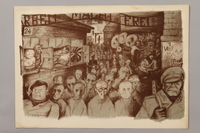
Portfolio
Object
Plate 5 in a folio of 12 prints by Leo Haas published in Prague in 1947. The works are based on scenes experienced or witnessed by Haas, a labor and concentration camp prisoner for nearly six years. Each print has an introductory paragraph by Milos Vacik, a poet jailed for anti-Nazi resistance activity. Haas, 38, a Czech Jew and professional artist, was arrested in 1939, deported to Nisko labor camp in Poland, and then shipped back to Ostrava in German occupied Czechoslovakia to do forced labor. In September 1942, he was sent to Theresienstadt ghetto-labor camp, where he and a group of fellow artists determined to secretly document the terrible conditions of daily life in the camp. In summer 1944, they were accused by the Gestapo of smuggling their 'gruesome', that is, truthful, work out of the camp. Haas was arrested and tortured. In October, he was deported to Auschwitz, and a month later, to Sachsenhausen. In February 1945, he was transported to Mauthausen and then Ebensee concentration camp, where he was liberated on May 4-5 by US troops.
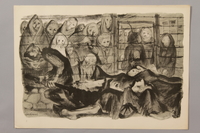
Portfolio
Object
Plate 6 in a folio of 12 prints by Leo Haas published in Prague in 1947. The works are based on scenes experienced or witnessed by Haas, a labor and concentration camp prisoner for nearly six years. Each print has an introductory paragraph by Milos Vacik, a poet jailed for anti-Nazi resistance activity. Haas, 38, a Czech Jew and professional artist, was arrested in 1939, deported to Nisko labor camp in Poland, and then shipped back to Ostrava in German occupied Czechoslovakia to do forced labor. In September 1942, he was sent to Theresienstadt ghetto-labor camp, where he and a group of fellow artists determined to secretly document the terrible conditions of daily life in the camp. In summer 1944, they were accused by the Gestapo of smuggling their 'gruesome', that is, truthful, work out of the camp. Haas was arrested and tortured. In October, he was deported to Auschwitz, and a month later, to Sachsenhausen. In February 1945, he was transported to Mauthausen and then Ebensee concentration camp, where he was liberated on May 4-5 by US troops.
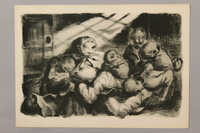
Portfolio
Object
Plate 8 in a folio of 12 prints by Leo Haas published in Prague in 1947. The works are based on scenes experienced or witnessed by Haas, a labor and concentration camp prisoner for nearly six years. Each print has an introductory paragraph by Milos Vacik, a poet jailed for anti-Nazi resistance activity. Haas, 38, a Czech Jew and professional artist, was arrested in 1939, deported to Nisko labor camp in Poland, and then shipped back to Ostrava in German occupied Czechoslovakia to do forced labor. In September 1942, he was sent to Theresienstadt ghetto-labor camp, where he and a group of fellow artists determined to secretly document the terrible conditions of daily life in the camp. In summer 1944, they were accused by the Gestapo of smuggling their 'gruesome', that is, truthful, work out of the camp. Haas was arrested and tortured. In October, he was deported to Auschwitz, and a month later, to Sachsenhausen. In February 1945, he was transported to Mauthausen and then Ebensee concentration camp, where he was liberated on May 4-5 by US troops.
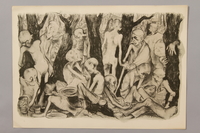
Portfolio
Object
Plate 9 in a folio of 12 prints by Leo Haas published in Prague in 1947. The works are based on scenes experienced or witnessed by Haas, a labor and concentration camp prisoner for nearly six years. Each print has an introductory paragraph by Milos Vacik, a poet jailed for anti-Nazi resistance activity. Haas, 38, a Czech Jew and professional artist, was arrested in 1939, deported to Nisko labor camp in Poland, and then shipped back to Ostrava in German occupied Czechoslovakia to do forced labor. In September 1942, he was sent to Theresienstadt ghetto-labor camp, where he and a group of fellow artists determined to secretly document the terrible conditions of daily life in the camp. In summer 1944, they were accused by the Gestapo of smuggling their 'gruesome', that is, truthful, work out of the camp. Haas was arrested and tortured. In October, he was deported to Auschwitz, and a month later, to Sachsenhausen. In February 1945, he was transported to Mauthausen and then Ebensee concentration camp, where he was liberated on May 4-5 by US troops.
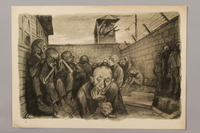
Portfolio
Object
Plate 10 in a folio of 12 prints by Leo Haas published in Prague in 1947. The works are based on scenes experienced or witnessed by Haas, a labor and concentration camp prisoner for nearly six years. Each print has an introductory paragraph by Milos Vacik, a poet jailed for anti-Nazi resistance activity. Haas, 38, a Czech Jew and professional artist, was arrested in 1939, deported to Nisko labor camp in Poland, and then shipped back to Ostrava in German occupied Czechoslovakia to do forced labor. In September 1942, he was sent to Theresienstadt ghetto-labor camp, where he and a group of fellow artists determined to secretly document the terrible conditions of daily life in the camp. In summer 1944, they were accused by the Gestapo of smuggling their 'gruesome', that is, truthful, work out of the camp. Haas was arrested and tortured. In October, he was deported to Auschwitz, and a month later, to Sachsenhausen. In February 1945, he was transported to Mauthausen and then Ebensee concentration camp, where he was liberated on May 4-5 by US troops.
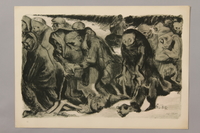
Portfolio
Object
Plate 11 in a folio of 12 prints by Leo Haas published in Prague in 1947. The works are based on scenes experienced or witnessed by Haas, a labor and concentration camp prisoner for nearly six years. Each print has an introductory paragraph by Milos Vacik, a poet jailed for anti-Nazi resistance activity. Haas, 38, a Czech Jew and professional artist, was arrested in 1939, deported to Nisko labor camp in Poland, and then shipped back to Ostrava in German occupied Czechoslovakia to do forced labor. In September 1942, he was sent to Theresienstadt ghetto-labor camp, where he and a group of fellow artists determined to secretly document the terrible conditions of daily life in the camp. In summer 1944, they were accused by the Gestapo of smuggling their 'gruesome', that is, truthful, work out of the camp. Haas was arrested and tortured. In October, he was deported to Auschwitz, and a month later, to Sachsenhausen. In February 1945, he was transported to Mauthausen and then Ebensee concentration camp, where he was liberated on May 4-5 by US troops.
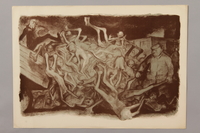
Portfolio
Object
Plate 12 in a folio of 12 prints by Leo Haas published in Prague in 1947. The works are based on scenes experienced or witnessed by Haas, a labor and concentration camp prisoner for nearly six years. Each print has an introductory paragraph by Milos Vacik, a poet jailed for anti-Nazi resistance activity. Haas, 38, a Czech Jew and professional artist, was arrested in 1939, deported to Nisko labor camp in Poland, and then shipped back to Ostrava in German occupied Czechoslovakia to do forced labor. In September 1942, he was sent to Theresienstadt ghetto-labor camp, where he and a group of fellow artists determined to secretly document the terrible conditions of daily life in the camp. In summer 1944, they were accused by the Gestapo of smuggling their 'gruesome', that is, truthful, work out of the camp. Haas was arrested and tortured. In October, he was deported to Auschwitz, and a month later, to Sachsenhausen. In February 1945, he was transported to Mauthausen and then Ebensee concentration camp, where he was liberated on May 4-5 by US troops.
Portfolio
Object
Descriptive booklet for a folio of 12 prints by Leo Haas published in Prague in 1947. The works are based on scenes experienced or witnessed by Haas, a labor and concentration camp prisoner for nearly six years. Each print has an introductory paragraph by Milos Vacik, a poet jailed for anti-Nazi resistance activity. Haas, 38, a Czech Jew and professional artist, was arrested in 1939, deported to Nisko labor camp in Poland, and then shipped back to Ostrava in German occupied Czechoslovakia to do forced labor. In September 1942, he was sent to Theresienstadt ghetto-labor camp, where he and a group of fellow artists determined to secretly document the terrible conditions of daily life in the camp. In summer 1944, they were accused by the Gestapo of smuggling their 'gruesome', that is, truthful, work out of the camp. Haas was arrested and tortured. In October, he was deported to Auschwitz, and a month later, to Sachsenhausen. In February 1945, he was transported to Mauthausen and then Ebensee concentration camp, where he was liberated on May 4-5 by US troops.




